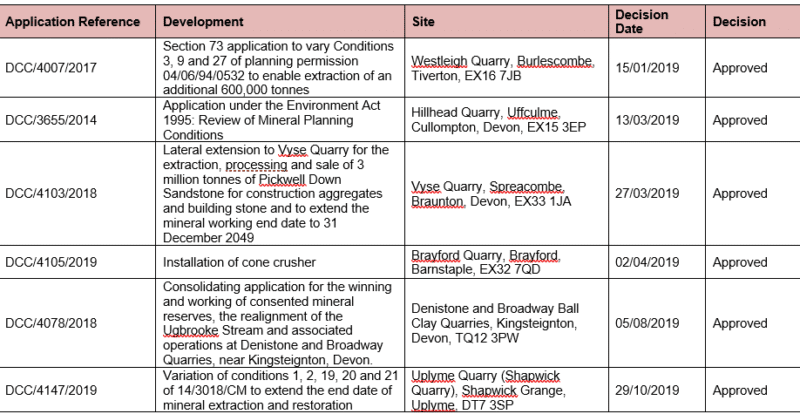Contents
1. Introduction
1.1 Minerals Planning in Devon
Devon County Council is the minerals and waste planning authority for Devon, with responsibility for preparing minerals and waste policies, determining minerals and waste planning applications and ensuring that development is in accordance with the planning permission granted. This excludes Dartmoor and Exmoor National Parks and the unitary authority areas of Plymouth and Torbay which are responsible for minerals and waste planning in these areas.
1.2 Purpose of the Monitoring Report
The Planning and Compulsory Purchase Act 2004 (the 2004 Act) (as amended) requires the County Council to produce Local Plans for minerals and waste planning in Devon. There is also the requirement to produce a Monitoring Report on the progress with, and implementation of, those Plans. The first Monitoring Report was published for 2004/05. All previous Monitoring Reporting are available on the County Council’s website
The scope and content of a planning authority’s Monitoring Report is the subject of legislation[1] to which Devon County Council has had regard. This Report monitors the County Council’s Minerals Plan in four areas:
- the progress of the County Council in implementing its Minerals and Waste Development Scheme;
- an assessment of the performance of the policies within the Minerals Plan;
- any action undertaken in accordance with the Duty to Cooperate; and
- Conclusions on the key findings of the Monitoring Report and any actions required to address the issues that have arisen, including any difficulties encountered in producing the report.
This Monitoring Report covers the calendar year of 2019. The Devon Minerals Plan was adopted in February 2017, at which time it replaced all previously saved policies from the earlier Devon County Minerals Local Plan 2004. This monitoring report uses the monitoring framework set out in Table 9.2[2] of the Devon Minerals Plan. These indicators have been developed in the context of the Minerals Plan’s overarching objectives and were scrutinised as part of the examination process.
[1] Planning and Compulsory Purchase Act 2004 (as amended) and The Town and Country Planning (Local Planning) (England) Regulations 2012
[2] Implementation and Monitoring Framework for the Devon Minerals Plan
1.3 Implementation of the Minerals and Waste Development Scheme
The 2004 Act (as amended) requires the County Council to prepare a Minerals and Waste Development Scheme [MWDS]. This Scheme is intended to provide a programme for the preparation of the development plan documents that will be contained within the Minerals and Waste Development Framework, and progress in implementing the MWDS is to be monitored through a Monitoring Report.
The Fifth Revision of the Minerals and Waste Development Scheme was published in March 2018[3] and notes the Minerals Plan as having been adopted. It indicates that in the event of an update to the Minerals Plan being required as a result of a review, a further revision of the Scheme will be prepared.
[3] Available in the Development Scheme tab of DCC’s Minerals and Waste Policy pages
2. Minerals Policy: Assessment of Performance and Effects
The below assessment of performance and effects is based on the indicators contained within the Implementation and Monitoring Chapter in Table 9.2 of the Devon Minerals Plan. It should be borne in mind that the number of planning applications for minerals development received by the County Council in any one year is small, and that a large proportion of the Plan policies may not be used in the determination of planning applications every year. A schedule of 2019 planning applications for mineral development is provided in Appendix 1.
This section of the monitoring report has been updated from previous years to provide results in a way which more clearly identifies where monitoring targets are not being met. This includes the adoption of a traffic light system for the results as defined below.

The indicators for each of the Plan’s six key objectives have been grouped into a table for each. Where indicators have score red as above, a review has been undertaken. This is presented after the results table for each objective.
2.1 Objective 1: Spatial Strategy
Indicators 1.1 – 1.5 seek to ensure minerals development adhere to the Spatial Strategy contained within the Devon Minerals Plan.
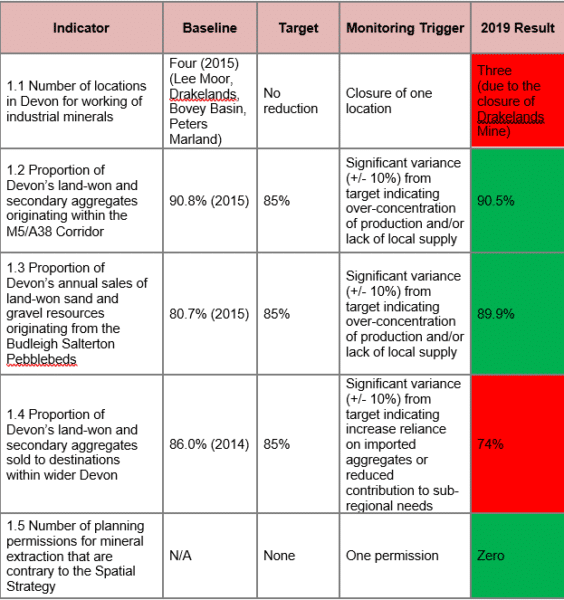
The results for the Spatial Strategy indicators are largely positive and meeting targets. In relation to indicator 1.1, the closure of Drakelands mine in October 2018 has resulted in the number of locations working industrial minerals to reduce from four to three. At the time of writing, the buyer has stated their intention to bring the mine back into operation in the near future and therefore an update to policy is not considered necessary at this stage.
In relation to indicator 1.4, the result of 74% means the monitoring trigger has been breached. This result suggests that a higher proportion of Devon’s land-won and secondary aggregates are being sold to destinations outside of wider Devon than in previous years. The outcome is very close to the trigger margin and therefore will continue to be monitored in future years, but it is not considered necessary to update the Minerals Plan at this stage.
2.2 Objective 2: Safeguarding Mineral Resources and Infrastructure
Indicators 2.1 – 2.2 seek to ensure policy is effectively safeguarding mineral resources and associated infrastructure from sterilisation by other forms of development.

The results for the Safeguarding Minerals Resources and Infrastructure indicators remain below their targets and outside the review trigger margin.
The County Council objected to development on mineral safeguarding grounds in a small number of cases, with the District Councils refusing planning permission for those applications except in four cases. This related to planning permission for:
- The conversion of a barn to holiday let in Kentisbeare (18/01957/FULL);
- Demolition of agricultural buildings and the conversion and extension of rural building to dwelling in Holcombe Rogus (19/01058/FULL);
- Erection of 5 dwellings in Uffculme (19/00914/FUL);
- The stationing of three holiday lodges in Chudleigh (18/01142/FUL).
Whilst this outcome is disappointing, the approvals relate to a very low number of small-scale applications. The Council continues to monitor new planning applications closely to ensure that it is able to make appropriate responses. It is not considered necessary to update the Minerals Plan policy as a result of this outcome.
There was no change in the number of operational mineral wharves and railheads in Devon during 2019. The reduction in the 2015 baseline from six to five facilities is due to one wharf in Appledore ceasing to be used for the landing of marine dredged sand and gravel in 2017. However, as two other wharves remain available in the locality, it is not necessary to seek replacement provision.
2.3 Objective 3: Industrial Minerals
Indicators 3.1 – 3.6 seek to ensure policy is maintaining Devon’s ability to assist in meeting national and international demand for those industrial minerals found within the County.
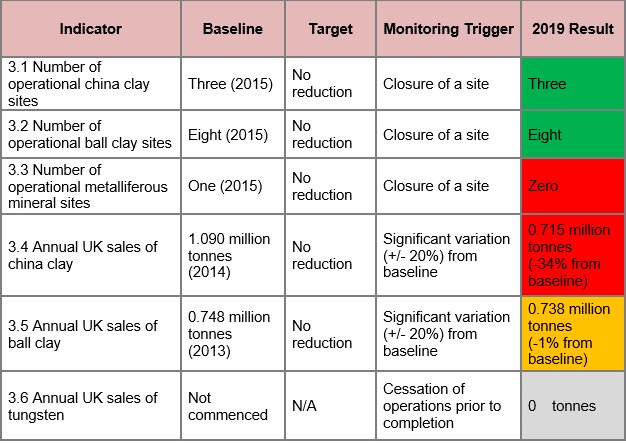
The 2019 results for the industrial minerals indicators are varied. The results for indicator 3.1 and 3.2 relating to the number of operational sites remained at their targets in 2019. Despite this, indicators 3.3 and 3.4 are both below their targets and outside the review trigger margin. Similarly, indicator 3.5 is below its target, however it is within the review trigger margin.
Relating to indicator 3.3, the number of operational metalliferous mineral sites has reduced to zero in 2019. This is due to the cessation of working at Drakelands Mine. However, as outlined in the 2018 monitoring review, the buyer has stated their intention to bring the mine back into operation in the near future and therefore an update to policy is not considered necessary at this stage.
With regard to indicators 3.4 and 3.5 and the sale of industrial minerals in 2019, the data indicates a reduction of 34% from the baseline in sales of china clay and a reduction of 1% for ball clay. Whilst the target has not been met for 3.5 the reduction reported is minimal and the eight operational ball clay sites in Devon continue to contribute to the national market. Similarly, whilst there has been a more significant UK wide reduction in the sales of china clay, the number of sites operating in Devon has not changed and therefore Devon sites continue to form an important part of the national supply. In this context it is not necessary to update related Minerals Plan policies at this stage.
2.4 Objective 4: Aggregate Minerals
Indicators 4.1 – 4.3 seek to ensure policy maintains a sustainable, steady and adequate supply of aggregates, making maximum use of the County’s resources of secondary and recycled materials and providing new resources when required.
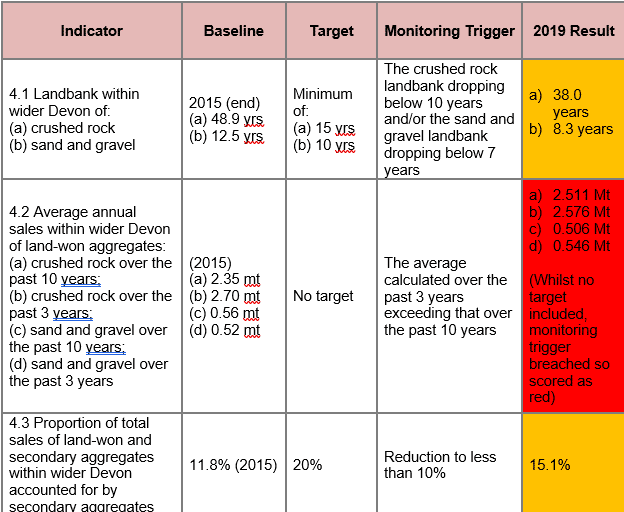
The landbank for land-won crushed rock remained above the target level, although the sand and gravel land bank has continued to dip further below the 10-year target. However, due to the sand and gravel landbank remaining above 7 years, a review of the Plan has not been triggered at this stage.
For the fifth year running, the three years sales average for crushed rock exceeded the ten years average, indicating increased recent levels of demand. However, in the view of the extensive crushed rock landbank, it is not necessary to trigger a review of the Plan at this stage, but the situation will continue to be monitored through the Local Aggregate Assessment.
For the third year running, the three years sales average for sand and gravel exceeded the ten years average, however as highlighted above, the landbank remains in excess of the 7 years minimum requirement by the NPPF and additional provision is made within the Minerals Plan. This will continue to be closely monitored over forthcoming years.
Sales of secondary aggregates dipped slightly from the previous year (0.549 million tonnes in 2019 compared to 0.558 million tonnes in 2018). However, the proportion secondary aggregates represented within the wider picture of land won and secondary aggregates remained broadly the same (15.1% in 2019 compared to 15.7% in 2018
2.5 Objective 5: Building Stone
Indicators 5.1 – 5.2 seek to ensure policy enables local distinctiveness by securing an appropriate supply of local characteristic building materials.
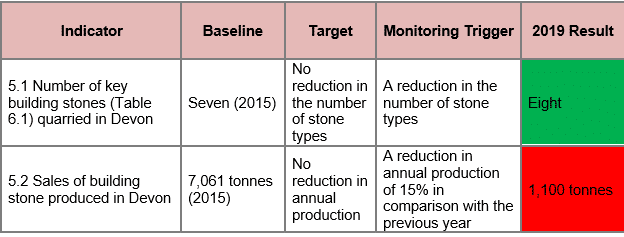
The result for indicator 5.1 remains the same as the previous year and above the target. However, the result for indicator 5.2 saw a decrease of 69% from the 2018 result of 3,572 tonnes. This outcome is therefore in excess of the 15% trigger margin and as such has been considered in more detail.
There are a number of factors to consider in relation to this result. Firstly, the way in which sales data was collected in 2019 was as part of the national aggregate mineral survey rather than the usual local survey. This different survey method may have resulted in a change in the way in which operators reported their data. A number of sites who usually report building stone sales did not include this as part of their survey responses and therefore it is likely there has been under reporting of building stone sales for 2019. Secondly, as highlighted in indicator 5.1, there continues to be a number operational quarries producing a variety of building stone within Devon and as such if an increase in demand occurred, there are adequate sites available to facilitate increased production. As such, this breach of the monitoring trigger is not considered to result in a need to update the Minerals Plan.
2.6 Objective 6: Managing Mineral Development
Indicators 6.1 – 6.9 monitor policies that seek to manage mineral development in a manner that protects Devon’s communities from adverse impacts, conserves and enhances its environment, delivers positive benefits for its quality of life, green infrastructure and assists in mitigation of & adaptation to climate change.
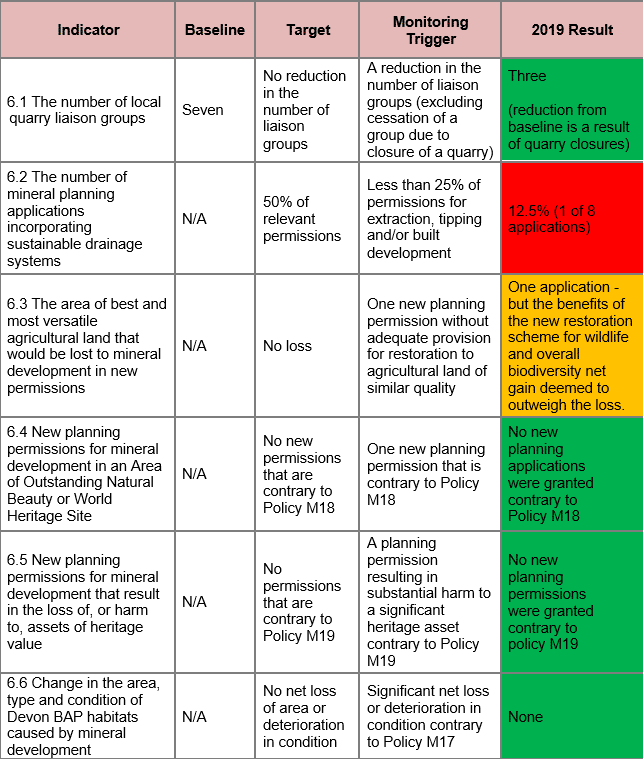
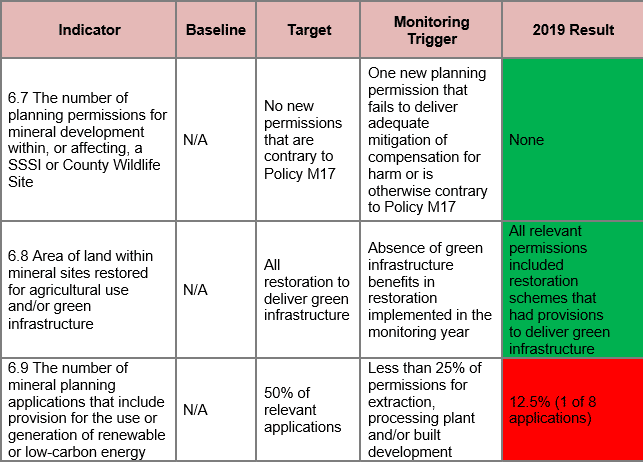
The results for the Managing Mineral Development indicators were varied in 2019. The majority (six) indicators met their targets (6.1 and 6.4-6.8), one indicator result was below its target but within the monitoring trigger (6.3) and two indicators were below their target and outside the monitoring trigger margin, these are 6.2 and 6.9.
In relation to Indicator 6.3, as outlined in the table, one application resulted in loss to an area of best and most versatile agricultural land. However, this was considered through the application process and the benefits of the new restoration scheme for wildlife and overall biodiversity net gain were deemed to outweigh the loss. As such this score could be adjusted from orange to green.
Regarding indicator 6.2, having reviewed the applications determined in 2019, whilst the result is low, this is not considered to be a result of missed opportunities to incorporate SuDS. Not all mineral development will alter surface water drainage or have flood risk implications so SuDS will not always be required. For example, a ROMP application may not incorporate SuDS as a suitable surface water system may already be in place, hence there is no need to alter it. DCC will continue to monitor new applications to see whether there is scope for more sustainable forms of drainage.
The 50% target for indicator 6.9 concerning renewable or low carbon energy was not met and the result fell below the monitoring trigger of 25%. A single permission granted during this period met this requirement which is a disappointing outcome for this indicator. It is not considered necessary to update the Plan as a result of this outcome; however, as highlighted in previous years, the policy requirement should be more effectively implemented in determining mineral planning applications going forward.
In relation to indicator 6.4, one application (DCC/4147/2019) was located within an AONB at the existing quarry in Uplyme, but due to the nature of the application (variation of condition to extend the end date of mineral extraction and restoration) this was not applicable to the consideration of these indicators.
In relation to indicator 6.5, one application (DCC/3655/2014) flagged potential impacts upon heritage assets through the determination process. However, an appropriate condition was applied for the permission to be granted in accordance with Policy M19.
With regard to Indicator 6.6, it was identified that two small pockets of land within the application boundary for DCC/4078/2018 were within a BAP habitat. However this was only a small area on the very edge of the habitat and therefore it was deemed to not have a significant impact on the BAP habitat.
3. Duty to Cooperate
The importance of working with our neighbours has been strengthened through the Localism Act and the introduction of the Duty to Cooperate. This Duty places a requirement for local authorities to work together on planning issues, including the development of planning policy documents. This ensures the effectiveness and deliverability of plans regarding strategic cross boundary matters.
Activities undertaken by Devon County Council in line with the Duty to Cooperate during the period of this Monitoring Report are summarised within this section.
3.1 Other Mineral Planning Authorities
In developing the Devon Minerals Plan, close liaison with other Minerals Planning Authorities meant that there were no objections raised in relation to the Duty to Cooperate.
Devon County Council has continued to coordinate data for aggregate minerals on behalf of the other wider Devon MPAs through 2019, partly due to its greater specialist resourcing and partly because the limited number of mineral sites in the other MPAs prevents them publishing sales and reserves data separately. The County Council undertakes annual aggregate surveys that cover wider Devon and prepares the Devon Local Aggregate Assessment in discussion with the other MPAs.
Devon County Council will continue to engage with the neighbouring MPAs, both directly and through the South West Aggregate Working Party (for which it provided the chairman from August 2016 to December 2017), and will contribute to development of their future Minerals Plans to ensure that cross-boundary issues are considered. In particular, dialogue will be maintained with Somerset County Council, regarding maintenance of a joint sand and gravel landbank taking account of potential supply from Somerset, and with Cornwall Council as outlined in a joint Memorandum of Understanding.
To ensure planning consistency across Devon’s MPAs, Devon County Council led on preparation of a joint minerals evidence base covering Devon, including Dartmoor, Plymouth and Torbay, to inform development of each MPA’s Minerals/Local Plans. It is intended that this set of Topic Papers is maintained as a ‘live’ resource and updated as necessary to inform the subsequent preparation of minerals policy by the other MPAs.
3.2 District Planning Authorities
Devon County Council participates extensively in the preparation of Local Plans by Devon’s district councils, and in Plans prepared by adjoining unitary and national park authorities, reflecting its roles as minerals and waste planning authority, highway authority and infrastructure provider. This participation includes ensuring that these Local Plans avoid constraining mineral resources and operations.
3.3 Other Relevant Organisations
In producing the Devon Minerals Plan formal engagement was carried out, in compliance with the specified organisations that fall within the scope of the Duty to Cooperate. The extent to which wider engagement in the development of the Plan has occurred is dependent on the degree to which individual organisations have an interest in minerals planning. Engagement has been most extensive with the Environment Agency and Natural England. As well as the designated Duty to Cooperate bodies, engagement has taken place with a range of organisations from the public and voluntary sectors.
4. Key Findings and Actions Required
4.1 Minerals and Waste development Scheme
As outlined in section 1.3, the Fifth Revision of the Minerals and Waste Development Scheme was published in March 2018 and notes the Minerals Plan as having been adopted. It indicates that in the event of an update to the Minerals Plan being required as a result of a review, a further revision of the Scheme will be prepared.
4.2 Implementation of the Devon Minerals Plan
The Devon Minerals Plan was adopted in February 2017 and this monitoring period represents the second full year in which the Plan’s policies have been fully in effect. Whilst this enables a consideration of the policies implementation, the number of planning applications for minerals development in each year remains low.
Chapter 2 shows that a positive approach is being achieved with minerals permissions granted in 2019, largely conforming to the Plan’s policies. Monitoring triggers have been breached for 7 indicators[4] as follows:
- Indicator 1.4: Proportion of Devon’s land-won and secondary aggregates sold to destinations within wider Devon reduced to 74%;
- Indicator 2.1: four district planning applications were approved contrary to an objection on mineral safeguarding grounds by the County Council;
- Indicator 3.4: Annual UK sales of china clay reduced by 34% from the baseline (in excess of the trigger margin);
- Indicator 4.2: the three years sales average for crushed rock exceeded the ten years average for the fifth year in a row and the three years sale average for sand and gravel exceeded the ten years average for the third year in a row;
- Indicator 5.2: Sales of building stone produced in Devon reduced by more than 15% from the previous year;
- Indicator 6.2: The number of mineral planning applications incorporating sustainable drainage systems was only 12.5%; and
- Indicator 6.9: Only 12.5% of relevant permissions made provision for use of renewable or low carbon energy.
Where breaches have occurred, these have been reviewed and discussed in this report. It is not considered necessary to update the Minerals Plan at this stage in light of these monitoring triggers being breached, however, this will continue to be monitored over future years.
[4] this does not include 2 breaches related to Drakelands mine which is anticipated to reopen in the near future.
Appendix 1 – Schedule of Minerals Planning Applications Determined in 2019
